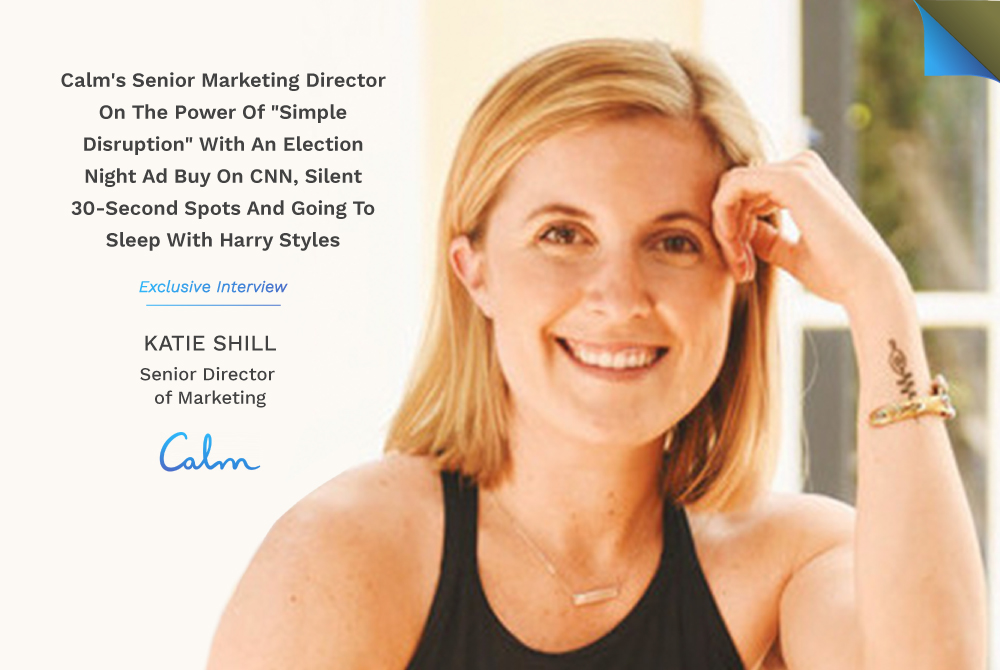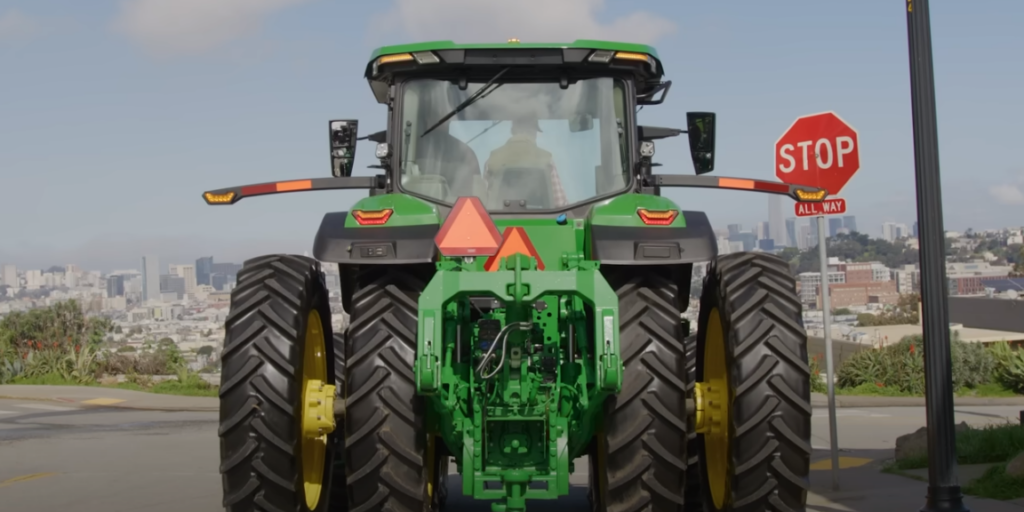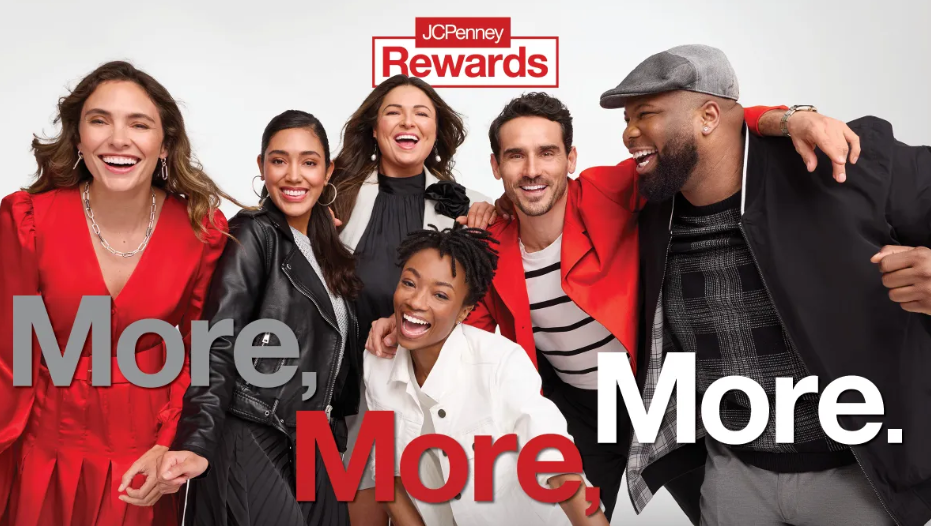When Katie Shill joined wellness app Calm in 2017, where she eventually rose through the ranks to become Senior Director of Marketing, she worked closely with co-founders Michael Acton Smith and Alex Tew to find ways she could bring their marketing philosophy of “simple disruption” to life.
So when Shill and her media team were presented with the opportunity to sponsor CNN’s key race alerts coverage during and post-Election Day, just one week before the polls closed on Nov. 3, she saw an ideal contextual showcase. Embedded into key ad breaks of CNN’s on-air coverage was Calm’s 30-second spot “Do Nothing,” which features no dialogue, just the sound of rain and the tagline “Do Nothing for 30 Seconds” to showcase the benefits of mindfulness and meditation.
“I joke that it’s probably one of the cheapest commercials of all time to make,” Shill says. “But it’s the most disruptive and the most simple, because when it’s sandwiched in between two loud commercials, the simplicity of just hearing rain on leaves gets people to look up from their phones and stare at the TV. While the core brand pillar of ‘simple disruption’ started before my time, it’s continued to be our biggest guiding light in a year like 2020.”
Though Shill knew the association with political content could be “inherently risky” for a brand, she leaned into the universality of the approach. “We knew no matter what side of the aisle you were on Election Night, it was going to be incredibly stressful for all of us.”
The risk paid off. Shill says Calm saw a 150% increase in Twitter mentions the week of the election, with a nearly 80% share of voice among its competitors across all social platforms. Custom research from CNN also found that Calm’s brand awareness was 34% higher among CNN consumers on Election Day and the day after vs. non-CNN consumers. The brand also received a large share of earned media from PR coverage of the sponsorship, with consumer headlines from Newsweek, Teen Vogue, Fortune and Techcrunch helping spread the word.
Sponsoring CNN’s election coverage helped cap off a year of rapid growth and cultural milestones for Calm, including an exclusive collection of Sleep Stories — a series of bedtime tales narrated by A-list celebs like Harry Styles, Laura Dern and Kate Winslet to help ease quarantine insomnia. The company has also created a free resources page for essential workers and first responders to gift them annual subscriptions and provide other pro bono tools to help them navigate the heightened anxieties of their work amid the COVID-19 crisis.
“Since March, we’ve seen our daily download numbers double,” Shill says, adding that Calm’s paid subscriptions now total 3 million, with 90 million downloads of the app to date. “We’re almost hitting that 100 million landmark. It’s so amazing because when I see that number I think, ‘That’s an incredible amount of people who have invested in taking care of their mental health.’”
Brand Innovators caught up with Shill from her home in San Francisco to learn more about the marketing strategy that’s steered Calm to stress-busting success, her biggest takeaways from the CNN sponsorship and how she’s keeping the same agile mindset for 2021. The conversation has been edited for length and clarity.
Brand Innovators: What appealed to you about Calm when you first joined the company in 2017, and what are some brand pillars you’ve helped identify for the company that have guided you as a marketer in the three years since?
Katie Shill: I downloaded Calm five years ago and had really loved the product and used it. I am a yoga instructor now, I wasn’t at the time, but I grew up with yoga and meditation in my household so I was pretty familiar with it. And when I moved from New York to San Francisco, I found out Calm was based in San Francisco, so they immediately came on my radar. It was a super small company of 20 people at the time. They really hadn’t made a dent yet, and I ended up getting connected to Michael and Alex, our co-founders. They were some of the first people I met at Calm. Their collective vision and energy was so palpable from the beginning. They were both incredibly creative, super smart marketers and had a vision from the very early days to build a global lifestyle brand. That enthusiasm and vision really drew me in. It’s hard to be in a meeting with those two and not feel really inspired.
What were some of Calm’s brand pillars that existed either prior to you joining or that you’ve since helped establish that define the Calm brand?
One of our core brand pillars, which I cannot take credit for, is “simple disruption.” That was evident in Alex and Michael’s marketing strategy from the very beginning when they were super small. And right now that has truly inspired our creative strategy across all channels – user acquisition, paid social, and our brand channels too. We even have a billboard in Times Square, where that same creative thinking very much applies. We do our best work when we show up in really anxious moments or anxious places with creative that’s really disruptive in its simplicity.
Calm expanded its original content in 2020 to better serve different dayparts for wellness, including meditation in the morning and Sleep Stories at night. What other types of content have you invested in this year?
When we think about building out content in the app, it’s one of our biggest differentiators compared to other players in the space. The wide range of content we have in the app is really intentional. For example, when you think about physical fitness and taking care of your physical well-being, what works for you could be different from what works for me, there’s so many different things. And we think of that in the same way as mental health.
So what works for you to help ease anxiety could be totally different than the tools that work for me. We can’t just double down on one type of content in our opinion. We want to ultimately serve as many different types of people. We have meditation content continuing to build that out, that’s super important. Sleep Stories are a really core part of our content strategy too, we often really like to work with celebrities and talent to help bring this magical element of sleep stories to life. It’s really fun to fall asleep to some of your favorite people like Matthew McConaughey or Harry Styles, super dreamy.
Music is a really core part to our content strategy too. It’s interesting, when you see mediation as an uptick in the morning and sleep stories uptick at night, music is quite steady throughout the day. We see people listening to music to help them focus at work. We have worked with a lot of really well known artists like Sam Smith, Kygo and Diplo to create exclusive tracks for Calm that are solely designed to help you relax and calm the mind.
And wisdom is a growing category for us as well. We have a new content type called “The Spark,” which features interesting conversations with well-known people in their field talking about neuroscience, sleep habits, the full gamut. They’re inspiring sessions that are meant to be a spark of new inspiration, new knowledge to get you going throughout the day.
From a media mix perspective, what platforms have you found best move the needle for you?
We have a pretty healthy mix across digital advertising on social channels, paid social, TV and podcasts. Paid social is a really interesting place when you think about it because that’s where people are mindlessly scrolling. We all know the feeling of waking up, grabbing your phone and realizing “I’ve been on social for 30 minutes.” So that’s a great way for Calm to be able to meet people and disrupt that mindless scrolling.
When people are disrupted by a Calm ad, hopefully that content in and of itself helps them relax or take their eyes off their screen. That also means they just got a two-second taste of what the product could do for them. It’s kind of a trial, if you think about it that way. So how do we disturpt people and give them a little taste of what the product could deliver? Our media strategy in general is quite centered around performance and ROI, so trials like that are really helpful.
Calm captured a lot of earned media and buzz from its sponsorship of CNN’s key race alerts on Election Night. What were your key takeaways from that program?
As marketers we often think when you show up for a big brand moment you need to say something new and try to think of a new way to approach something to break through. But in this election moment, we saw the power in the simplicity of just showing up. If you think about the key race alert sponsorship, it was this anxiety filled stream that said “Calm.” That simple juxtaposition goes back to our brand pillar of simple disruption. We didn’t say anything, it was the name Calm juxtaposed against one of the most anxiety inducing screens you could look at.
So that, accompanied with our commercials, was really important because people saw the app icon but when they experienced the “Do Nothing” commercial it gave them a bit of taste of what we could actually offer and how we could support them in that moment. It was also really cool to see how it was a smart paid media buy, that then drove social conversation that then led to an incredible wave of PR. So it was a great collaboration between all the marketing, PR and social teams to make that happen.
How are you approaching planning cycles for 2021 now that you have heightened brand awareness? Are you thinking bigger in terms of media buys and campaigns?
The election taught us something, because the opportunity to sponsor the key race alerts came the week before the election. It was a last minute call. So we are thinking about how we can prepare our teams for 2021 to be able to empower them to take risks, to give them the autonomy and tools to lay the foundation so that we as a brand are able to react more quickly. If 2020 taught us anything, it’s that plans can be thrown out the window in any given moment.
What’s your prediction for marketers in 2021?
For Calm, and for a lot of other brands, this year we’ve seen the power of our community and hearing really unbelievable stories of our users. So in 2021, I think there’s a lot of opportunity to lean into community and redefine what community even looks like. We learned our users are the core of our product. They’re the ones who are having these transformational experiences. So we’re looking at how we can support them in deeper ways. I think Peloton has done a really incredible job of leaning into their community and putting the storytelling into their hands.
Also in 2021, assuming that COVID may linger, I think looking at production is really fascinating to see how brands are pivoting for marketing. It’s almost leveled the playing field in some ways, very few people have the luxury of big, high-quality, high-price point production. There’s beauty in looking at really raw content that feels more real, so people can see themselves in it, and it looks like a brand that has pivoted to create content and bring some humanity to the work. I’m hopeful that more marketers will lean into that rawness and humanity, because there’s so much power in that.
Andrew Hampp is an entertainment marketing consultant for Brand Innovators and the founder of consultancy 1803 LLC, based in Berkeley, California.




